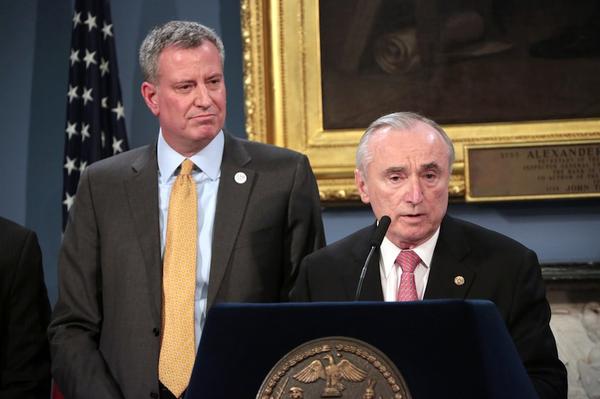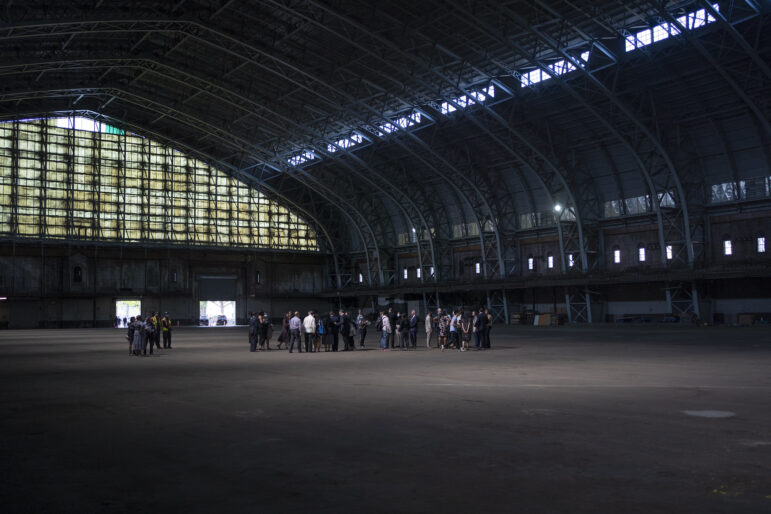
Photo by: Rob Bennett for the Office of Mayor Bill de Blasio
One of police Commissioner Bratton’s first moves was to revamp Operation Impact, which the Bloomberg administration had used to flood high-crime areas with large numbers of rookie officers. The program won’t disappear, but it’s changing.
At the end of January, Commissioner William Bratton announced that the city would reform Operation Impact. But those changes have not yet been seen in Brownsville, and some suggest that they hope they don’t.
Started in 2004, New York City’s Impact Zones were high-crime areas around the city where police officers fresh out of the academy would train. Critics charged that the new officers were not properly supervised and were more likely to perform unnecessary stops, linking it with the controversial stop, question and frisk policy.
Earlier this year, Bratton said that the program will change: Rookie cops would instead train in their home precincts. The first rookie police class subject to the change will graduate later this year.
“I would hope to potentially expand it using seasoned officers or these young kids teamed up with a seasoned officer,” Bratton said to reporters, according to the New York Daily News.
The portion of Brownsville that falls within Police Service Area 2, which covers the neighborhood’s public housing, is an impact zone. For local residents, the question of how this new policy will impact public safety remains unclear. Many residents and groups that work with residents cite public safety as a chief concern.
According to Anthony Newerls, the president of the Precinct Community Council, there have been no changes in police presence in the neighborhood do far. “I don’t think we can afford any changes,” he says.
Police encounters already less common
Stop-and-frisk has already been dramatically scaled back. Stops in the city’s precincts declined dramatically from 61,727 stops in the first quarter of 2013 to 8,999 stops in the last three months of 2013.
In Brownsville’s 73rd Precinct, 751 stops were recorded in the first three months of 2013; 3,020 were recorded in Police Service Area 2 during that same time period. During the last three months of 2013, there were 21 stops recorded in the 73rd Precinct and 242 in PSA 2.
Among people who work in the justice system, that change is being greeted warmly. James Brodick, the executive director of the Brownsville Community Justice Center, which works with young offenders in order to lower crime and incarceration rates, says that since most people’s entry to the criminal justice system is via the police, better police interactions improves the perception of the entire system.
While he says that many older people may feel an improvement in the relationship between police and the community, sentiment among younger people may take longer to thaw. “The wounds are too fresh in many of their minds,” he says.
Newerls agreed that interaction between police and the community could be improved, saying that he had suggested workshops to his local commanding officer on stop, question and frisk that could help engage the community with officers.
Margaret Brewer, the community board’s public safety committee chairperson, said that the relationship has improved in recent years, crediting Deputy Inspector Joseph Gulotta, who has led the 73rd Precinct for three years, with part of that change.
Crime stays low
By many metrics, Brownsville’s public safety is on par with or better than prior years. According to the 73rd precinct’s CompStat for the week of March 2, the last week for which data is publicly available, there had been an 80 percent decline in rapes compared to this point last year; the precinct also logged decreases in robberies (2.6 percent), burglaries (7.7 percent) and grand larceny (5.5 percent).
But the picture was not entirely rosy. There has been an uptick in the number of assaults; nearly a third more shootings that claimed a victim were recorded this year.
At one recent Van Dyke Resident Association meeting, residents spoke about a February incident in which an elderly resident was attacked and robbed while getting off the elevator. Indeed, the first item on the agenda, after the invocation, was “Attack on senior citizens and residents at Van Dyke I Houses and the community”.
Meanwhile, a flyer that was given to meeting attendees had been created by the NYPD: “LOCK YOUR CAR DOOR…Even at the gas pump. Thieves are preying on YOU at gas stations and stealing property in a flash.”
But for Brewer, the solution to Brownsville’s public safety concerns does not just lie with the police, but with the neighborhood as well. A member of the community board for six and a half years, Brewer became chairperson about a month ago.
At last week’s committee meeting, Brewer discussed the return of a Police Department program, Block Watchers, which has recently gained favor in other neighborhoods as well. In an interview, she expressed hope that residents would be more responsive to a neighbor than they might be with a uniformed police officer.
“We can’t wait anymore,” she said. “Summer’s coming in around the corner.”









